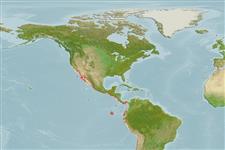Teleostei (teleosts) >
Syngnathiformes (Pipefishes and seahorses) >
Syngnathidae (Pipefishes and seahorses) > Syngnathinae
Etymology: Hippocampus: Greek, ippos = horse + Greek,kampe = curvature (Ref. 45335).
More on author: Girard.
Environment: milieu / climate zone / depth range / distribution range
Ecology
Marine; reef-associated; non-migratory; depth range 0 - 60 m (Ref. 30915), usually 3 - 18 m (Ref. 5227). Subtropical; 37°N - 22°S, 123°W - 70°W
Eastern Pacific: confirmed records from San Diego in California, USA to Peru including the Galapagos Islands.
Reported from the San Francisco Bay by Alexander Agassiz (Ron Fritzsche, pers.comm. 08/09).
Length at first maturity / Size / Weight / Age
Maturity: Lm 5.4 range ? - ? cm
Max length : 30.0 cm TL male/unsexed; (Ref. 2850)
Short description
Identification keys | Morphology | Morphometrics
Nocturnal. Occur in offshore waters, mostly captured by dredging at 10 m or deeper. Occasionally caught at surface. Are often camouflaged within the branches of gorgonians and black coral trees where they are seen to curl their tail around the branches (Ref. 5227). Have been found in the stomachs of Pacific yellowfin tuna and bluefin tuna (Ref. 30915). Ovoviviparous (Ref. 205). The male carries the eggs in a brood pouch which is found under the tail (Ref. 205).
Male carries the eggs in a brood pouch (Ref. 205). Gestation period is 14-15 days depending on temperature (Ref. 30915).
Lourie, S.A., R.A. Pollom and S.J. Foster, 2016. A global revision of the seahorses Hippocampus Rafinesque 1810 (Actinopterygii: Syngnathiformes): taxonomy and biogeography with recommendations for further research. Zootaxa 4146(1):1-66. (Ref. 115213)
IUCN Red List Status (Ref. 130435)
Threat to humans
Harmless
Human uses
Fisheries: commercial; aquarium: commercial
Tools
Special reports
Download XML
Internet sources
Estimates based on models
Preferred temperature (Ref.
123201): 19.1 - 28.5, mean 24.3 °C (based on 131 cells).
Phylogenetic diversity index (Ref.
82804): PD
50 = 0.5000 [Uniqueness, from 0.5 = low to 2.0 = high].
Bayesian length-weight: a=0.00447 (0.00177 - 0.01127), b=3.00 (2.78 - 3.22), in cm total length, based on LWR estimates for this (Sub)family-body shape (Ref.
93245).
Trophic level (Ref.
69278): 3.3 ±0.38 se; based on food items.
Resilience (Ref.
120179): High, minimum population doubling time less than 15 months (tm=0.3-0.4).
Fishing Vulnerability (Ref.
59153): Low vulnerability (20 of 100).
Nutrients (Ref.
124155): Calcium = 71.1 [33.9, 167.8] mg/100g; Iron = 1.28 [0.60, 2.43] mg/100g; Protein = 18.7 [17.3, 20.0] %; Omega3 = 0.164 [0.069, 0.364] g/100g; Selenium = 32.1 [12.6, 86.2] μg/100g; VitaminA = 22.8 [5.6, 102.3] μg/100g; Zinc = 1.08 [0.61, 1.78] mg/100g (wet weight);
